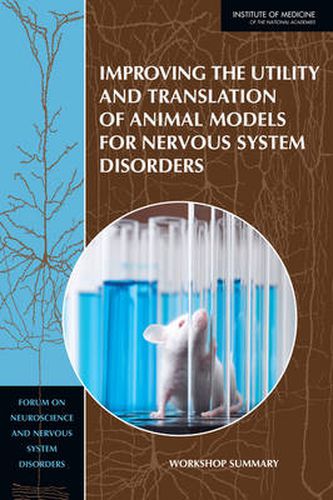Readings Newsletter
Become a Readings Member to make your shopping experience even easier.
Sign in or sign up for free!
You’re not far away from qualifying for FREE standard shipping within Australia
You’ve qualified for FREE standard shipping within Australia
The cart is loading…






Nervous system diseases and disorders are highly prevalent and substantially contribute to the overall disease burden. Despite significant information provided by the use of animal models in the understanding of the biology of nervous system disorders and the development of therapeutics; limitations have also been identified. Treatment options that are high in efficacy and low in side effects are still lacking for many diseases and, in some cases are nonexistent. A particular problem in drug development is the high rate of attrition in Phase II and III clinical trials. Why do many therapeutics show promise in preclinical animal models but then fail to elicit predicted effects when tested in humans?
On March 28 and 29, 2012, the Institute of Medicine Forum on Neuroscience and Nervous System Disorders convened the workshop Improving Translation of Animal Models for Nervous System Disorders to discuss potential opportunities for maximizing the translation of new therapies from animal models to clinical practice. The primary focus of the workshop was to examine mechanisms for increasing the efficiency of translational neuroscience research through discussions about how and when to use animal models most effectively and then best approaches for the interpretation of the data collected. Specifically, the workshop objectives were to: discuss key issues that contribute to poor translation of animal models in nervous system disorders, examine case studies that highlight successes and failures in the development and application of animal models, consider strategies to increase the scientific rigor of preclinical efficacy testing, explore the benefits and challenges to developing standardized animal and behavioral models. Improving the Utility and Translation of Animal Models for Nervous System Disorders: Workshop Summary also identifies methods to facilitate development of corresponding animal and clinical endpoints, indentifies methods that would maximize bidirectional translation between basic and clinical research and determines the next steps that will be critical for improvement of the development and testing of animal models of disorders of the nervous system.
$9.00 standard shipping within Australia
FREE standard shipping within Australia for orders over $100.00
Express & International shipping calculated at checkout
Nervous system diseases and disorders are highly prevalent and substantially contribute to the overall disease burden. Despite significant information provided by the use of animal models in the understanding of the biology of nervous system disorders and the development of therapeutics; limitations have also been identified. Treatment options that are high in efficacy and low in side effects are still lacking for many diseases and, in some cases are nonexistent. A particular problem in drug development is the high rate of attrition in Phase II and III clinical trials. Why do many therapeutics show promise in preclinical animal models but then fail to elicit predicted effects when tested in humans?
On March 28 and 29, 2012, the Institute of Medicine Forum on Neuroscience and Nervous System Disorders convened the workshop Improving Translation of Animal Models for Nervous System Disorders to discuss potential opportunities for maximizing the translation of new therapies from animal models to clinical practice. The primary focus of the workshop was to examine mechanisms for increasing the efficiency of translational neuroscience research through discussions about how and when to use animal models most effectively and then best approaches for the interpretation of the data collected. Specifically, the workshop objectives were to: discuss key issues that contribute to poor translation of animal models in nervous system disorders, examine case studies that highlight successes and failures in the development and application of animal models, consider strategies to increase the scientific rigor of preclinical efficacy testing, explore the benefits and challenges to developing standardized animal and behavioral models. Improving the Utility and Translation of Animal Models for Nervous System Disorders: Workshop Summary also identifies methods to facilitate development of corresponding animal and clinical endpoints, indentifies methods that would maximize bidirectional translation between basic and clinical research and determines the next steps that will be critical for improvement of the development and testing of animal models of disorders of the nervous system.